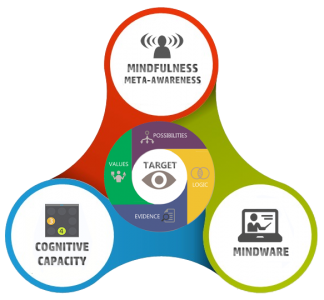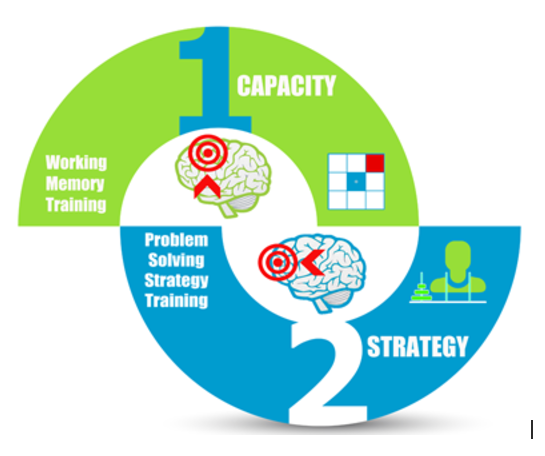Scientific Basis of HighIQPro’s Gated Dual N-Back
.
![]()
We know from an often skeptical scientific press that many brain training apps claimed to improve cognition do not work beyond practice effects. The popular scientific press has sometimes taken an anti-brain training stance.
But it has become clear from an ever-growing volume of peer-reviewed research that some types of brain training are effective for increasing cognitive ability and IQ. We need to filter out the placebo results and hone in on those which show effectiveness under the exacting standards of placebo-controlled, double blind, laboratory studies – those that meet the exacting standards of peer-reviewed scientific journals.
Working Memory Brain Training
“The results of individual studies encourage optimism regarding the value of working memory training as a tool for general cognitive enhancement.” Morrison & Chein review.
Working memory (Gwm) is one of the broad abilities of general intelligence. It is your ‘mental workspace’ – the limited amount of content (verbal, spatial, images) you can process ‘online’ and focus on for problem solving, reasoning, planning, comprehending & decision-making. Working memory is limited capacity – you can only activate some information from all the knowledge and memories held in your long term memory at any given time.
The Classic Dual N-Back
One of the most well-known working memory training methods is the dual n-back. This is a game that involves keeping track of continuously changing audio letters and shape locations, and responding when there is a match ‘n’ times back in the sequence – as shown here.
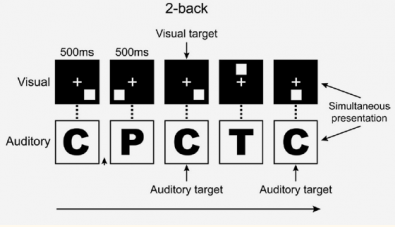 Dual n-back game
Dual n-back game
This figure shows a 2-back game. The game is adaptive so that if you get good at this, you go up to a 3-back, 4-back, 5-back and so on.
Have a look at this October 17th 2017 Johns Hopkins University press release about a study published that week on dual n-back training. The study was published in the Journal of Cognitive Enhancement and can be found here Johns Hopkins researchers suspected the problem wasn’t the idea of effective brain training, but the type of training exercise researchers chose to use.
The training exercises Johns Hopkins compared are not the commercial products typically available and sold to consumers, but a lab-designed dual n-back.
There were three groups in the study: One group trained with the dual n-back, another group trained with another working memory exercise called the symmetry span task, and a third (control) group trained with a challenging verbal logic task that did not involve working memory. Everyone took a round of cognitive tests, trained five days a week for 30 minutes, then returned to the lab for another round of tests – including brain EEG recordings – to see if anything about their brain or cognitive abilities had changed.
The researchers found that the group that practiced the dual n-back exercise showed a 30% improvement in their working memory – a core component of Central Hub Intelligence. That was nearly double the gains made by the group working with the other working memory exercise.
The dual n-back group also showed significant changes in brain activity in the prefrontal cortex, the critical region responsible for general intelligence.
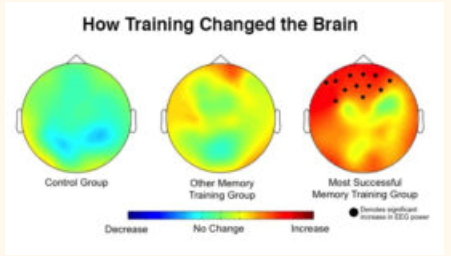
This Johns Hopkins’ study adds to the message of the multiple brain imaging studies (ref 1, ref 2, ref 3) showing neuroplasticity change in the the Fronto-Parietal Network (FPN) as a result of dual n-back training. As we reviewed in Psychometric IQ Augmentation 2, the FPN is the brain’s ‘control hub’ underlying Central Hub Intelligence. This neural network sends out top down signals for current task goals and exerts control by flexibly biasing information flow across multiple large-scale functional networks. The FPN is a key network underlying intelligent, goal directed action and learning.
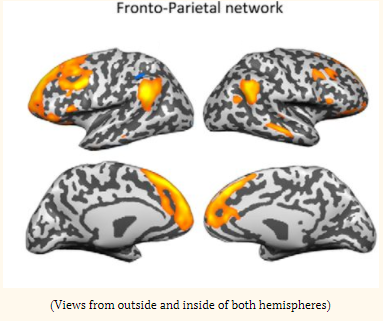
Cognitive neuroscience and neuroimaging research has demonstrated the following as a result of dual n-back training:
- Functional connectivity within the Fronto-Parietal Network increases following training, and the magnitude of increased connectivity is tied to improvements in task performance (ref).
- Working memory training increases grey matter volume in the Fronto-Parietal Network (ref).
- Working memory training results in neuroplasticity change in dopamine receptors in the Fronto-Parietal Network. The neurotransmitter dopamine is very important for working memory and working memory performance is affected by dopamine levels in the prefrontal cortex, with dopamine release observed during the performance of working memory tasks (ref1, ref2).
This Johns Hopkins study also adds to the dual n-back behavioral studies that have been analyzed in recent ‘meta-reviews’. The conclusion of these reviews is that there are real IQ augmenting training effects of DNB brain training beyond placebo effects and just getting good at the n-back game itself through practice (review 1, review 2).
The very latest 2017 meta-review of 33 published, randomized, controlled DNB trials from independent labs all around the world (review) finds there are real (non-placebo) training effects of DNB brain training on:
- Other n-back games – the biggest effect
- Working memory (Gwm)
- Fluid reasoning / Fluid intelligence (Gf)
- Attention Control
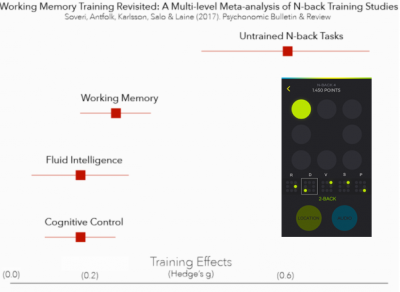
How should we interpret these ‘training effects’? The effect size for working memory capacity (Gwm) is 0.24. Let’s take another kind of intervention to compare. 0.24 is the same effect size of antidepressants such as Fluoxetine in treating depression (ref). Certainly a lot is invested into developing anti-depressants. So we should take notice of this kind of effect size when it comes to augmenting IQ.
While dual n-back benefits for working memory (Gwm) have been consistently demonstrated, there has been controversy concerning dual n-back training benefits for Fluid reasoning ability (also called ‘fluid intelligence’), but the weight of the evidence indicates otherwise as you can see. The effect is small but real. Dr Au and colleagues’ earlier 2015 meta-analysis also found the same effect size of dual n-back brain training on fluid reasoning (ref), and they argue:
“the results reported in this meta-analysis represent a low-end estimate of the true extent of improvement that n-back training can have on measures of fluid intelligence.”
So we have two independent groups, reviewing all the available evidence on DNB training, coming to the same conclusion about training benefits for Fluid reasoning (Gf), as measured by matrices IQ tests.
In conclusion, dual n-back training works. It improves IQ through neuroplasticity change, and it does so to a useful extent.
There are multiple n-back apps available online. i3 Mindware is one. Ensure that you choose one that implements a lab-tested program and that you commit to program completion.
Cognitive Control Training (CCT)
The standard dual n-back is a working memory (Gwm) training intervention; it trains working memory updating. The dual n-back js not designed to train executive attention control functions.
There is another class of brain training interventions called executive control training or cognitive control training (CCT), specifically designed to activate areas of the brain that allow us to control and direct our attention and adjust our thoughts and actions when confronted with conflict during information processing. Due to central role of attention control in the Central Hub of Intelligence, this training strategy makes a lot of sense for IQ augmentation.
Dual N-Back with Interference Control Training
The Central Hub of Intelligence can be thought of as the seat of flexible problem solving and adaptation to new task-demands in the face of interference or information conflict. Interference control is the ability to filter out distracting information that attracts attention and resolve information-conflict. Interference control is of particular value in our Attention Economy, where all-pervasive information continually consumes the scarce resource of our attention, and where there is a need to filter out distractions and resolve information conflicts as we pursue our goals and projects.
The first study that looked at the dual n-back with built-in interference control training found that compared to the standard dual n-back interference training resulted in improved attention control (ref). It also resulted in increased electrical signalling in the parietal cortex (part of the Fronto-Parietal Network). This, they concluded:
“may be related to improvements in processing speed, attentional control, or both”
In a recent 2017 study, dual n-back and interference control training – compared to standard dual n-back training – resulted in improvements in both memory and language (ref). The researchers conclude:
“domain-general cognitive control mechanisms are plastic…and may play a causal role in linguistic and nonlinguistic performance”
Neuroimaging research shows that interference control underlies the link between fluid reasoning/intelligence (Gf) and working memory (Gwm) (ref 1, ref 2).
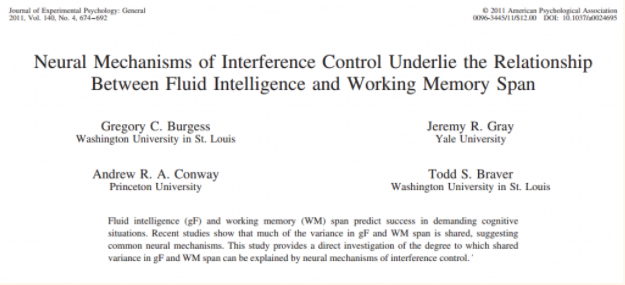 Note that ‘fluid intelligence’ is fluid reasoning ability
Note that ‘fluid intelligence’ is fluid reasoning ability
Interference control training is built into some dual n-back game apps (e.g. HighIQPro, Dual N-Back Pro & Brain Workshop) through carefully designed sequencing of the stimuli to create information conflict. What has been a target for a while suddenly switches to becoming a distraction in the game, requiring that you exert attention control to stop responding to it. This makes the dual n-back more challenging, and provides more effective training
HighIQPro games also include the ‘Stroop’ n-back’ based on the Stroop Task) – a variation of the dual n-back in which you need to ignore the meaning of words (red in the example here), and just respond to matches of the words’ color (blue). To get a feeling for the interference control needed for this n-back task, try quickly saying the ink colors, ignoring the color names, in this set of words. This is the Stroop Task.
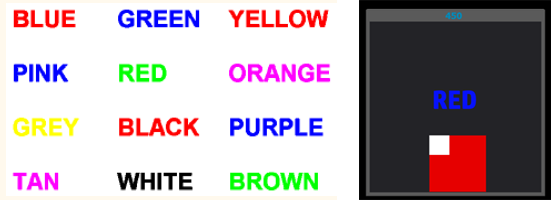
Task Switching & Selective Attention Training
Another cognitive control task developed for improving attention control and broader measures of intelligence is task switching (review).
Task switching training involves having to selectively attend to only some features of the information available to your senses (ignoring others) to perform a task, and then flexibly changing the features you attend to based on an updated rule set. The rules of the game change unpredictably based on some cue. Three studies looking at the benefits of task switching training compared the effects of training children (8–10), young adults (18–26) and older adults (62–76), and found training benefits for untrained executive control tasks and fluid intelligence (Gf) across all age groups (review).
Executive control selective attention and task-switching training is implemented in HighIQPro and i3 Mindware brain training apps in their ‘gated’ dual n-back games. Input gating, for example, requires the flexible switching between four streams of information rather than the standard two (audio and visual) in the dual n-back.
Output Gating Training
Not all information that you are keeping ‘online’ in the mental workspace of working memory may be useful for what you are currently trying to do. For instance, you need to apply the instructions you’re holding in working memory, just one step at a time. In Cohen’s model of working memory shown below, you can see that the focus of attention at any given moment selects from all the information that is active in working memory.
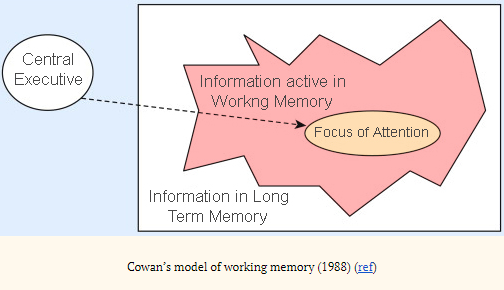
This kind of selection from workspace information depends on another executive control function called working memory output gating. Studies have shown that output gating, like selective attention and task switching, depends on the Fronto-Parietal Network (as well as corticobasal ganglia circuits)(ref, review).
Output gating is particularly important for the application and learning of abstract, higher order rules – precisely what is needed for psychometric IQ. It is needed for all these IQ-related abilities (ref1, ref2, ref3):
- Applying complex rules
- Generalization and learning from single cases
- Complex reasoning
- Complex decision making
- Complex planning
HighIQPro and i3 Mindware are the only apps on the market incorporating output gating brain training.
For those already familiar with the dual n-back training, the output gating is shown below. In the top panel sequence the ‘division’ cue tells you to only respond for a 2-back match when either the location or the letter match on their own but not when they both match at the same time. In the bottom panel the ‘equals’ cue tells you to only respond for the 2-back match when there is a location and letter match at the same time, but not when either of them matches on its own.
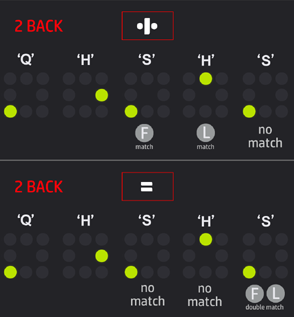
Example sequences for output gating in the dual n-back
Mindware Training
‘Mindware’ is a term for the knowledge, procedures and strategies you use to solve particular types of problem and think more effectively. Gated DNB brain training improves your ability to override knee-jerk, automatic responses while you problem solve, reason or make decisions – through input gating and interference control training. At the same time it gives you a carefully designed tutorial course that enables you to develop better applied IQ skills for better cognitive performance, productivity and innovation.
Working memory output gating circuitry is located in the lateral prefrontal cortex. Activation in this area allows for the flexible application of a wider range of novel strategies and rules (ref), overcoming automatic responses. These new rules – with output gating training – are more effectively encoded in more anterior (to the front of the head) prefrontal areas (ref). We call this ‘Capacity-Strategy’ brain training.
Continuous Cognitive Performance Tracking
To enable you to track your brain training gains from HighIQPro, there are short pre, mid and post-training tests – each a standard test in the field of cognitive neuroscience – for:
- attention flexibility
- attention focus
- processing speed
- learning
- reasoning (matrices)
- working memory (spatial)
- working memory (verbal)
Scientific References
Au, J., Buschkuehl, M., Duncan, G. J., & Jaeggi, S. M. (2015). There is no convincing evidence that working memory training is NOT effective: A reply to Melby-Lervåg and Hulme. Psychonomic Bulletin & Review. Oct, 2015.
Au, J., Sheehan, E., Tsai, N., Duncan, G. J., Buschkuehl, M., & Jaeggi, S. M. (2015). Improving fluid intelligence with training on working memory: a meta-analysis. Psychonomic Bulletin & Review, 22(2), 366-377. Abstract
Barbey, A. K., Colom, R., Paul, E. J., Grafman, J. (2013). Architecture of fluid intelligence and working memory revealed by lesion mapping. Brain Structure and Function, 219, 2. 485-94. Article.
Barbey, A. K., Colom, R., Solomon, J., Krueger, F., Forbes, C., & Grafman, J. (2012). An integrative architecture for general intelligence and executive function revealed by lesion mapping. Brain, 135(4), 1154–1164. https://doi.org/10.1093/brain/aws021
Bogg, T., & Lasecki, L. (2014). Reliable gains? Evidence for substantially underpowered designs in studies of working memory training transfer to fluid intelligence. Frontiers in Psychology, 5, 1589. Abstract.
Braver, T. S., and Cohen, J. D. (2000). “On the control of control: the role of dopamine in regulating prefrontal function and working memory,” in Control of Cognitive Processes: Attention and Performance VIII, eds S. Monsell and J. S. Driver (Cambridge, MA: MIT Press), 713–737.
Greenwood, P. M., & Parasuraman, R. (2015). The Mechanisms of Far Transfer From Cognitive Training: Review and Hypothesis.Neuropsychology. [Ahead of print].
Hindin S.B., Zelinski E.M. Extended Practice and Aerobic Exercise Interventions Benefit Untrained Cognitive Outcomes in Older Adults: A Meta-Analysis. Journal of the American Geriatrics Society.2012;60(1):136–141. [Article]
Karbach, J., & Verhaeghen, P. (2014). Making working memory work: A meta-analysis of executive-control and working memory training in older adults. Psychological Science, 25, 2027–2037.
Karr J.E., Areshenkoff C.N, Rast P, Garcia-Barrera M.A. (2014). An Empirical Comparison of the Therapeutic Benefits of Physical Exercise and Cognitive Training on the Executive Functions of Older Adults: A Meta-Analysis of Controlled Trials. Neuropsychology, 28(6):829-45. [Article]
Jaeggi, S.M., Buschkuehl, M., Jonides, J., & Perrig, W.J. (2008). Improving fluid intelligence with training on working memory. Proceedings of the National Academy of Sciences of the United States of America, 105(19), 6829-6833. Abstract / Article
Metzler-Baddeley, C., Caeyenberghs, K., Foley, S., & Jones, D. K. (n.d.). Task complexity and location specific changes of cortical thickness in executive and salience networks after working memory training.NeuroImage. https://doi.org/10.1016/j.neuroimage.2016.01.007
McGrew, K. S. (2009). CHC theory and the human cognitive abilities project: Standing on the shoulders of the giants of psychometric intelligence research. Intelligence, 37(1), 1–10. https://doi.org/10.1016/j.intell.2008.08.004
Melby-Lervag, M., & Hulme, C. (2013). Is working-memory training effective? A meta-analytic review. Developmental Psychology, 49, 270– 291. Abstract.
O’Reilly RC, Frank MJ. (2006). Making working memory work: A computational model of learning in the prefrontal cortex and basal ganglia. Neural Comput. 18(2):283–328. [PubMed]
Preusse, F., Elke, van der M., Deshpande, G., Krueger, F., & Wartenburger, I. (2011). Fluid Intelligence Allows Flexible Recruitment of the Parieto-Frontal Network in Analogical Reasoning. Frontiers in Human Neuroscience, 5. https://doi.org/Abstract
Thompson, T. W., Waskom, M. L., & Gabrieli, J. D. E. (2016). Intensive Working Memory Training Produces Functional Changes in Large-scale Frontoparietal Networks.Journal of Cognitive Neuroscience, 1–14. https://doi.org/Abstract
Schwaighofer, M., Fischer, F., Buhner, M. (2015) Does Working Memory Training Transfer? A Meta-Analysis Including Training Conditions as Moderators. Educational Psychologist 50, 2. Abstract, Article.


